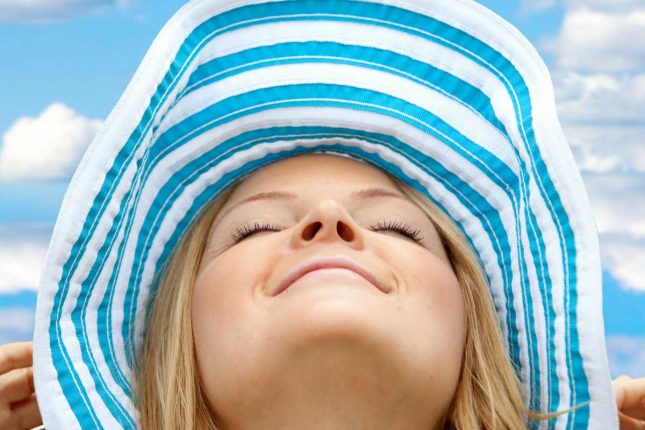There are several reasons why New Zealanders have a higher risk for developing skin cancers – including a high proportion of the population with fair skin, our low ozone levels and our cultural emphasis on ‘the great outdoors’. Keeping sun safe is not optional in our country, it’s essential.
This article looks at how we can be safe in the sun, while still maintaining important Vitamin D levels.
What is UV radiation?
Our unique environment causes us to be particularly vulnerable to damaging ultraviolet rays. Ultraviolet, or UV, is radiation released by the sun.
There’s 3 types of radiation the sun releases: UVA, UVB and UVC.
UVA radiation is the most common. This form of radiation goes deep into the skin, and is responsible for long term damage like wrinkles, blotchiness and some skin cancers.
UVB radiation is less common as the ozone absorbs much of it. This form of radiation gets into the top layer of the skin and causes sunburn, and skin cancer.
UVC is the most dangerous form of radiation. But fortunately the ozone and oxygen absorb all of this form of radiation, so none of it reaches the earth.
Skin cancer in New Zealand
New Zealand has one of the highest rates of skin cancer in the world, and together with Australia we have the highest melanoma rates.
Worldwide rates of skin cancer per capita
- Skin cancer is the most common cancer in this country – almost 80% of new cancer cases in New Zealand are skin cancers.
- There are nearly 67,000 new skin cancers a year, including 2400 new cases of melanoma.
- There are over 300 deaths from skin cancer annually.
- Maori and Pacific Islanders represent a low percentage of the overall skin cancers diagnosed, however they’re more likely to suffer from fast-growing and difficult to diagnose melanomas.
- Skin cancer is largely preventable. Over 90% of all skin cancer cases are attributed to excess sun exposure.
What does skin cancer look like?
According to the Cancer Society, skin cancer is categorised as melanoma or non-melanoma. The 3 most common skin cancers are:
- Melanoma – the most serious form of skin cancer, causing over two thirds of total skin cancer deaths.
- Squamous cell carcinoma (SCC) – easily treated if found early but can be fatal if left untreated.
- Basal cell carcinoma (BCC) – the most common and least dangerous skin cancer. BCC can be serious, requiring surgery if left untreated.
Here’s the 5 signs of a skin cancer, according to Dr. Axe.com:
Keeping safe in the sun
As skin cancer is so serious, it’s vital that parents teach children in New Zealand how to be sun safe. And the best mode of teaching is to model sun safety ourselves!
So how can we do that? Learn the latest version of the ‘slip, slop and slap’ below, and repeat them all the time in your family. And get your children to repeat them too, until they become is natural as putting on your seatbelt in the car.
The key is to make sure you think about each aspect of the below before spending time in the sun. You don’t ever want this to be an afterthought.
Going to the park? Make sure you bring a sun umbrella. Going for a walk to the shops? Make sure the kids have their hats on. Going for a drive in the car? Make sure everyone has sunglasses for the journey.
Thinking in this way, and making sure your kids are involved (so they can remind you when you forget to sunblock them before school!), will start to form a sunsafe habit in your household.
Shade – Then Slip, Slop, Slap and Wrap
- SHADE: Limiting your UV exposure from sunlight is best achieved by keeping in the shade as much as possible. If you plan to sit on the beach (or somewhere else in the sun) often as a family, a sun umbrella is a great investment.
- SLIP: If being in direct sunlight is unavoidable, cover your skin with clothing. Think about putting a long sleeve t-shirt, and long, light pants on yourself and your children. A small amount of discomfort now could prevent serious repercussions later.
- SLOP: Sunscreen should be used in addition to covering your skin, not instead of. Always have on hand some SPF 30+ sunscreen – check it hasn’t expired and store it in a cool location. Apply sunscreen at least 15 minutes before sun exposure, and reapply every 2 hours, or after swimming. Use about a teaspoon on each limb, and 1/2 a teaspoon on other exposed areas.
- SLAP: Slap on a hat that covers your scalp, neck and ears, and that shades your face. Have spare sunhats for the family kept in the car, so you are not caught out.
- WRAP: Wear sunglasses that block UV to protect your eyes and the skin around them. The best sunglasses will state on them that they meet Australian/New Zealand standards for UV protection.
The sun is harshest between the months of September and April in New Zealand. And it’s strongest between the hours of 10am and 4pm – so it’s best to apply the above practices throughout this period.
Also be careful around reflective surfaces at any time of the year – including snow and water. They make the effects of the sun on the skin much worse.
Should you use special children’s sunscreen?
Special children’s sunscreen isn’t required, so long as your child doesn’t react to regular sunscreen.
Children’s sunscreen is often a milder but effective version. It often comes in a 50+ version. And it’s usually a thicker cream than some standard brands.
In terms of the contents, it’s generally considered the benefits of sunscreen far outweigh any concerns over the products used in sunscreen formulation.
Something that’s far more important than a special child’s formulation, is the SPF rating of the sunscreen, and whether or not its a ‘broad-spectrum’ suncream. Each year Consumer.org.nz release the results of their sunscreen product tests. And almost every year a number of products totally fail to meet the claims on their packaging. We strongly suggest you only buy Consumer recommended sunscreens!
The importance of Vitamin D
Vitamin D is most readily absorbed into the body through exposure to sunlight.
Vitamin D is important for staying healthy. It’s essential for bone growth and healthy immune function. And a lack of Vitamin D has been linked to SAD (Seasonal Affective Disorder).
When weighed up, however, the benefits of being sunsafe outnumber those of getting high enough Vitamin D levels.
To get necessary Vitamin D while keeping safe in the sun:
- Get outdoors when the sun is not at its harshest – before 10am, or after 4pm, especially between September and April.
- From May to August, try and expose your skin to sunlight for short bursts each day, and it’s useful to do this when the sun is at its brightest.
- People with pale skin need to expose their skin to sunlight for about 20 minutes a day. People with darker skin may need 2 or 3 times this amount.
- Your body can only produce a limited amount of vitamin D each day. So to keep an optimum level of Vitamin D, you need to expose your skin to sunlight at least every other day.
Some people will require Vitamin D supplements to stay in optimum health – including some individuals with naturally dark skin, those unable to get outside due to disability, illness, people taking certain drugs, and those who have had skin cancer previously.
Pregnant women, and breastfeeding mothers, should have their Vitamin D levels checked, and consider taking a supplement if they’re deficient.
Your doctor can assist you if you believe your Vitamin D levels are too low. It could also be useful to see a dietitian, as diet has a role to play in Vitamin D levels and its absorption into the body.
A note on sunbeds
Sunbeds are never a safe option if you’re feeling ‘sun-starved’, or believe you’re Vitamin D deficient. They should be avoided by you and your children as their effects are directly linked to skin cancer.
The Ministry of Health no longer recommends the use of sunbeds, and legislation was passed in 2017 banning all use of sunbeds by those aged under 18.
There are many wonderful things about living in New Zealand, but our proximity to dangerous UV rays is not one of them!
We need to be vigilant for the sake of our families, and adhere to SunSafe principles at all times. Hopefully one day being ‘SunSafe’ will be as natural as wearing seatbelts in this country.
For more information on Vitamin D, check out this article on preventing osteoporosis. You may also want to read this article about SunSafe in schools. Or, for more great health advice, check out our Health and wellbeing section for Preschoolers.









Thanks. This is really informative and useful. I am so glad that you have covered all the details here. I have question about vitamin D. As you have said above that at least 20 min of sun is good for getting Vitamin D body need. But I have also read above that more than 10 min of direct sun exposure could invite other challenges. May I know if you are asking to have sun for 20 min with SPF cream on?
That’s a really great question. Vitamin D is a vital nutrient our bodies use for a whole heap of functions. It helps our bodies to absorb calcium, so strong bones, it builds a healthy immune system, and is linked to preventing depression (https://www.kiwifamilies.co.nz/articles/sad-winter-blues/). Sunscreen doesn’t stop you from absorbing vitamin D from the sun (it may reduce it slightly, but you’ll still get plenty of D from the sun), so definitely use sunblock when you’re outside. Also, try to get your vitamin D intake in the mornings or afternoons, when the sun is less severe. Hope that helps — Kiwi… Read more »